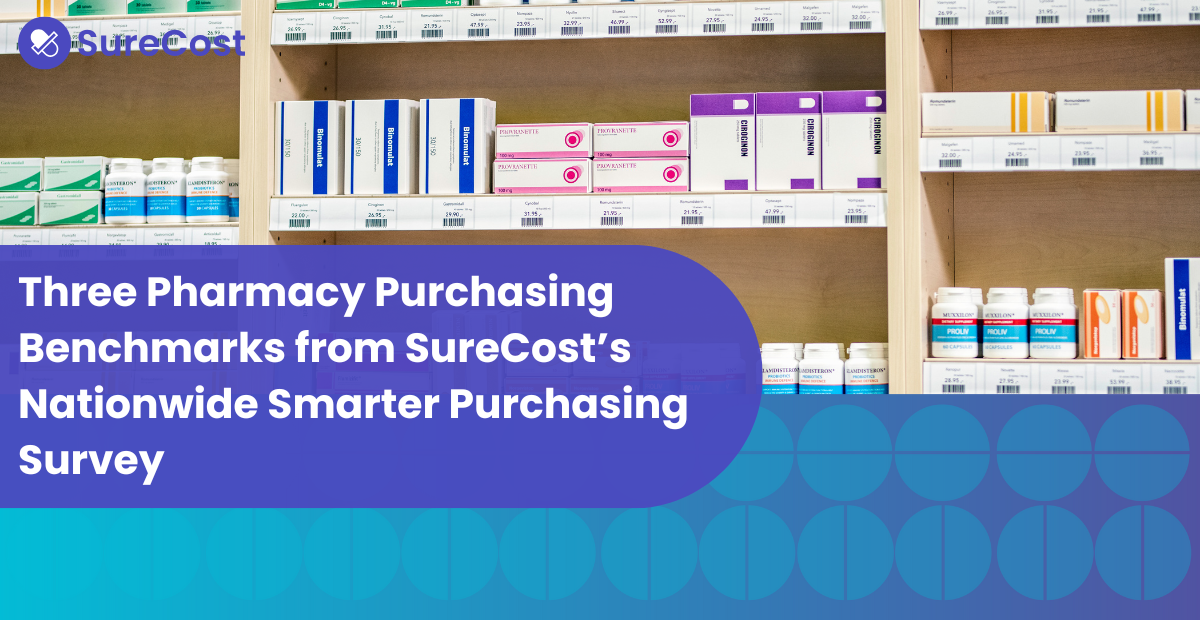No pharmacy professional wants tedious technical tasks taking them away from patients. But procurement can often feel that way. That’s why automated purchasing makes such a huge difference.
An automated purchasing platform will identify and help you order products that you select according to your rules and parameters. The system can check availability, compliance, brand name versus generic, single- or multi-source and other variables. It can also order based on criteria look such as historical usage, perpetual inventory data points and product availability. The best automated purchasing systems also compare true costs, so you get that product through the ideal channel that maximizes your best financial outcome.
Automated purchasing reduces repetitive, time-consuming processes so you and your team can focus on other priorities. Every hour you avoid stressing over the same daily order is an hour you gain to consult with patients, check shelves for expired goods or plan how to improve your business.
More time with patients, greater efficiency and increased team satisfaction are just a few reasons to use automated purchasing. But what’s the best way to utilize this technology? What decisions should be automated to save time and stress, and which ones should you analyze each time? How do you ensure you’re getting the most out of your automated purchasing?
While every pharmacy’s needs and processes vary, here are five tips any pharmacy can use to optimize their automated purchasing.
1. Let Technology Handle the Simple Stuff
Automated purchasing aims to make your purchasing easy, so start by examining the hardest parts of your purchasing. Why do certain steps or orders take up so much time? You might need to step back and analyze your purchases. But take the time. It’ll be worth it. You should get that “bird's-eye view” of your purchasing habits before you get too deep into configuring automation.
Some orders themselves might be simple, but you may not have the time or staff to process them. If you always order the same item at the same time, if you know a vendor always gives you the best outcome (whether it be price, compliance or both) for a certain generic, or the decision points for selecting a product are straightforward, those are perfect use cases for automation. You program the logic and let the platform repeat the order as needed.
For more complex orders, where the right choice depends on a particular context and there are multiple options, you’ll have to determine and then program each scenario.
For example, maybe an item has historically unreliable availability data due to frequent shortages or vendor allocation issues. Instead of worrying about trying your luck with a vendor and circling back the next day, let the system review your list of next-best sources (or items) for you; that way, you can be confident that you’ll get the product if it’s available—and whatever you get will be the best option possible at the time. This allows you to stress less at ordering time. Remember that you can always come back later with reports for follow-up issues with your vendors.
Depending on the number and complexity of those unique scenarios, you may need to hold off on automating these specific purchases. But take the time to outline these decision points up front. You want the automation to reflect your choices. Trial and error shouldn’t be an option when it means mistakes that might affect your patients or your budget.
Automation may not be ideal for more complex decision points—especially those requiring a human touch. For example, if a frequent patient at your pharmacy insists that the brand-name version of their prescription works better than the generic, the right financial and personal decision may be to stay with the brand name (even if it's financially disadvantageous to both you and your patient. You wouldn’t want a fully automated purchasing system automatically ordering the cheapest type of that drug without regard for your patient’s preference.
2. Set Up Tripwires for High-Dollar Purchases
Some items are so costly they should constantly be scrutinized. It might be a product that’s expensive on its own or a purchase that costs you significantly more than expected. Maybe it’s an entire class of items. Either way, ordering too many of a certain item or paying for the wrong thing can hamper your cash flow and affect your bottom line.
Think of automated purchasing as a “tripwire” for goods with a larger-than-average impact on your budget. For those items, you can set proper workflow steps before the purchase is made. You could program purchasing rules to alert you about cost overruns before initiating the purchase. If an item “trips” the system, you can immediately respond in real time—rather than waiting until your next report to discover a cost overrun and wasteful effort on returns management!
Clients moving to automation have told me they now sleep easier because they don’t worry about these high-impact purchases slipping through the cracks. Sometimes purchasing managers describe the stress surrounding a missed opportunity that they just didn’t have the time or sightline to catch. While they can learn retroactively from something like a missed opportunity report, they recognize that correct proactive choices are always preferred. This can bring a sense of buyer's remorse every time they hit that “Send” button on the nightly order (often after recognizing that the day got away from them.)
This is where it’s exciting to see the impact of tools like SureCost when the purchasing rules and configurations are tuned in. Purchasers become superheroes with their semi-autonomous counterpart working as an extension of their minds 24/7. And superheroes always sleep better when they know their world is safe!
3. Regularly Review Your Purchasing Rules
Like good seasonal housekeeping, you should periodically “clean up” your automated purchasing. Review your current parameters, compare them with your business analytics and goals and update your automated purchasing rules accordingly.
Turn your regular business events into opportunities to audit your automated purchasing and optimize rules according to the latest data. Quarterly reports are a perfect point to review automated purchasing. You’re already comparing that quarter’s costs of goods sold (beginning inventory + purchases - ending inventory) and seeing how the trends line up with your P&L and business goals.
Why stop there? For example, instead of just reviewing dollars spent, you might compare the volume used or dollars spent against your trajectory towards a tiered manufacturer or wholesaler rebate. If you moved more or less items this quarter than expected, maybe the next best rebate is closer or further than you anticipated. Adjust your rules accordingly so you don’t leave more money sitting on the table next quarter.
Maybe you’re focused more on annual savings and spending and looking at the quarter as a milestone. Great! How are you updating your purchasing (automated or otherwise!) to reflect those objectives based on where you’re performing today?
Automated purchasing should not be a “set it and forget it” process. Think of it as another dynamic aspect of your purchasing strategy that needs to reflect your operations and goals.
4. Set Purchasing Rules According to High-Impact Categories
Automated purchasing can be set for individual products, but at a certain point, applying unique purchasing rules at that granular level might not be practical. Even with automation, tracking every NDC number to find trends can get overly complicated; you need too many rules to make it effective. And the whole reason for automated purchasing is to work smarter, not harder.
Consider automating based on the categories with the biggest impact. You’ll spend less time setting up unique rules for each product, and you’ll get to see overarching spending patterns that can inform your purchasing strategy. While some operational realities like automation can be constraints here, don’t use them as an excuse to not look at the whole picture.
For example, let’s say injectable antivirals accounted for 20% of your actual goods but were 80% of your spend. Would it make sense to add purchasing rules for that category as a whole (rather than a few specific items in that category)? Could you then adjust that category spend for a better return?
Focusing on a few categories—rather than reviewing the whole gamut every period—may show you big spikes in spending, which could indicate regular purchases that warrant automation. Jump on big spikes as a signal for unnecessary risk due to a lack of controls. Once they’re identified, set your objective to trend these categories toward their healthy level one or two categories at a time over a quarter.
Remember that a healthy level doesn’t necessarily mean less product. You should always consider multiple data points—such as prescribing trends, drug shortages, shelf life and other key factors—to make sure the spike you’re focused on is solved best through the purchasing department.
5. Keep People Involved in Automation
Every pharmacy I speak to is excited by how automated purchasing can make things easier for their staff. While the advantages may be clear to leadership, they’re not necessarily the ones who will be using the platform every day.
Change management needs to start before implementation. Make sure everyone understands the goals and what reaching them means. Ensure that they know their unique role in driving that change.
You may need to be creative in achieving buy-in, but it’s easier than you may think: frame the situation with the reality that business growth and profitability is everyone’s goal. Even if someone is focused on quality, patient care, budgets, or operational flow, it all ties in to better outcomes for everyone involved with and served by the business.
Once the objective is clear, introduce the tool you’ve selected and explain your decision process. What else did you consider? Who else was involved in the decision? What reservations were held but accepted or compromised on? (Pro tip: A decision is rarely well-made and tested if everyone agrees from the start!)
From here, show your team the new interface. Explain how it will save them time and reduce their stress. In addition to clarifying the value, make sure people feel that they’re part of the discussion and instrumental in making the system effective for the pharmacy.
Whether you’re setting up automated purchasing for the first time or updating your rules, make sure everyone affected by those rules has a voice. For example, if purchasing increased, did our prescription volume also increase? If so, within which drug categories? Are contract provisions “talking to” the purchasing rules? Make sure all stakeholders in your purchasing strategy are at the table.
Finally, always keep in mind the limitations of technology. That may sound counter-intuitive. Isn’t technology here to improve things?
Technology is there to help you do your work. Some staff may see “automation” and hear “replacement.” But as our earlier examples showed, technology can’t accommodate all contexts and relationships. “Fully automated” is neither possible nor desired.
Automated purchasing is a tool to help staff work better. It doesn’t do the work for people; it helps make their job easier. With these tips, the right solution and a knowledgeable team behind the technology, you can make automated purchasing as effective as possible.
Are you ready to learn more about how SureCost can help your pharmacy save more, work smarter and stay compliant? Book a meeting to speak with our experts.




.png)



